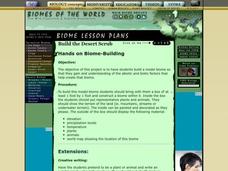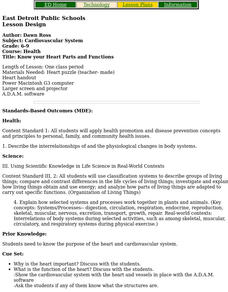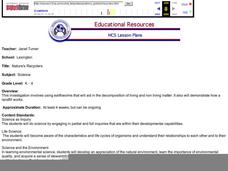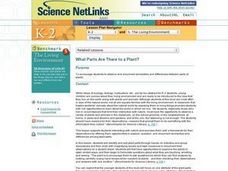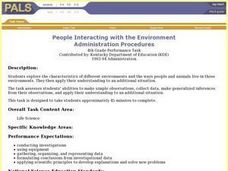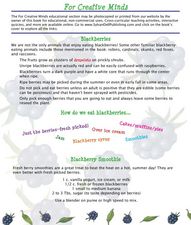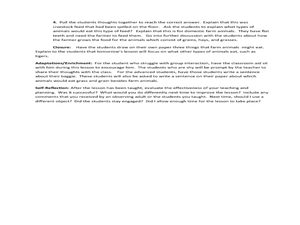Curated OER
Classifying Living and Non-Living Objects
Students investigate living organisms and define the properties of a living species. In this life characteristic lesson plan, students examine plants in their class and discuss whether or not they are alive. Students create a living...
Curated OER
Traveling Nitrogen
Students demonstrate and understanding of the nitrogen cycle by taking roles and interacting with others in a simulation activity.
Curated OER
The Intertidal Zone
Young scholars research the diverse animal and plant life that inhabit the intertidal zones along the Pacific rocky coast. As students progress through this lesson, they begin to recognize distinct behaviors, adaptations, and...
Curated OER
Spring of Life
Students explore Florida's springs using video segments. In this video lesson plan, students examine Florida's springs ecosystem, the animals that live there and the red tide that threatens the environment. The lesson plan includes...
Curated OER
Hands On Biome-Building
Students create a model biome to understand the abiotic and biotic factors that go into creating a biome. In this biomes lesson plan, students should display plants, animals, temperature, precipitation, and more.
Curated OER
Build the Taiga: Hands on Biome-Building
Students explore environmental awareness by completing a construction project. In this biomes lesson, students identify the different elements for life to thrive in an ecosystem. Students utilize a cardboard or wood box to create a biome...
Curated OER
Changing Sounds
Students identify how the pitch and the loudness of an instrument can be altered. In this online science of sound instructional activity, students employ the use of an interactive whiteboard to examine the loudness and pitch of a guitar,...
Curated OER
Pushes and Pulls
Students examine different types of movement and causes that may affect those movements. In this online interactive forces and motion lesson plan, students use toy cars to observe push and pull and then make predictions and collect data...
Curated OER
Flower Dissection
Pupils investigate th anatomy of a flower. They investigate the structures and processes by which flowering plants generate pollen, ovules, seeds, and fruit through dissection,
Curated OER
Hands On Biome-Building
Students create a desert biome to understand the abiotic and biotic factors of that biome. In this desert biome lesson plan, students include elevation, precipitation, temperature, plants, and more.
Curated OER
Food Web Follies
Seventh graders cut and paste animal pictures to create a food web and trace the path of energy. They write a paragraph explaining the importance of photosynthesis in all food webs.
Curated OER
Learning from the Video Clips
Students view a wilderness video and write to explain the purpose of the video. In this wilderness video lesson, recognize how physical and living parts of the environment interact. Students understand how an ecosystem works.
Curated OER
Know your Heart Parts and Functions
Students put together a 3-D interactive "heart" puzzle and learn the names of heart parts.
Curated OER
Nature's Recyclers
Learners create environments to demonstrate how earthworms interact with their surroundings.
Curated OER
The Discovery of Photosynthesis
Young scholars explore how scientists discover photosynthesis. In this biology lesson plan, students identify the basic requirements for photosynthesis to happen. They recreate past scientists' experiments and record their observations.
Curated OER
What Parts Are There to a Plant?
Students identify and sort plant parts through hands-on activities and group discussions and then work with magnifying lenses and tape measures to document their observations on a student sheet.
Curated OER
Bread Cells
Fifth graders examine plant and animal cells. In this plant and animal cell lesson, 5th graders define what cells are, label their parts, and describe how plant and animal cells are different. They observe cells at a number of web sites,...
Curated OER
People Interacting with the Environment
Students explore an arctic, temperate, and tropical environment and then decide what people need in each environment to help them live comfortably and what their lives would be like.
Curated OER
Hands on Biome-Building
Learners explore Earth science by participating in an environment activity. In this biome lesson plan, students discuss the importance of a healthy ecology in order to sustain life, both animal and plant. Learners utilize a cardboard or...
Curated OER
A Rainbow Under the Sea: How Do Animals Survive in the Ocean?
Second graders, with adult help, create a PowerPoint presentation on a selected ocean animal.
Curated OER
Land Associations
Students identify and explore life forms of various biomes, define transitional regions, examine effects of abiotic and biotic interactions, research a biome, and produce newspaper that features environmental information. Lessons all on...
Curated OER
Blackberries
Learners read and answer questions about other animals that like blackberries besides humans. In this blackberries lesson plan, students read about what animals like to eat blackberries and what they do for them.
Curated OER
What's in it and Who Eats it?
First graders explore farming by illustrating images. In this livestock activity, 1st graders discuss what types of plants are used to feed livestock animals and how pets and humans eat the livestock animals. Students draw images of what...
Curated OER
Seasons
Students name the 4 seasons, discussing the weather, plant life, animal life and and activities of each. Students read the book titled, "Hello Arctic," and and discuss changes in seasons that accompany the story. Students complete...











